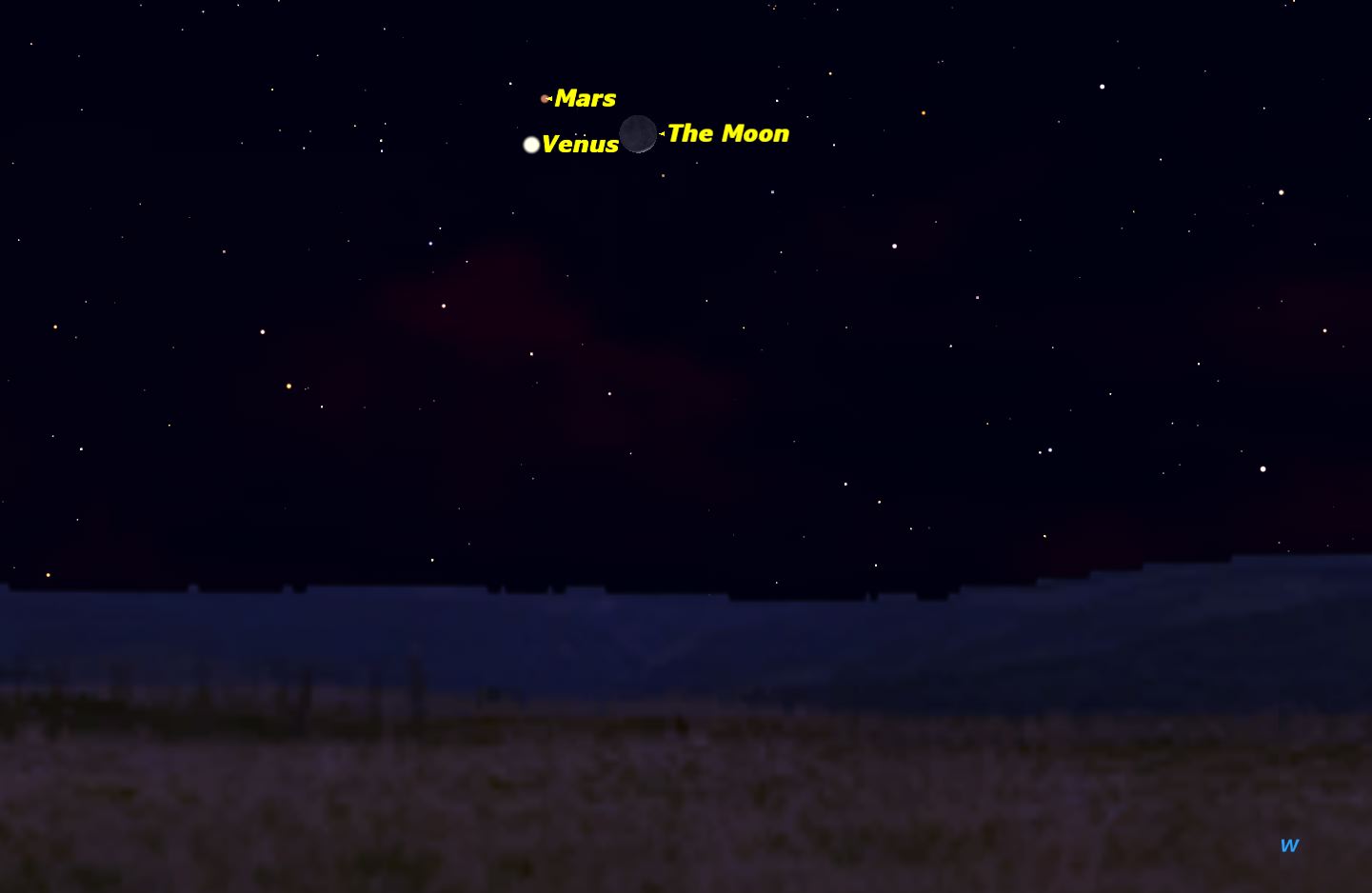Moon, Venus, Mars Meet in Friday Night Sky: How to See It

Mars, Venus and the moon will meet up in a particularly beautiful cosmic display Friday (Feb. 20).
If you've been watching the evening twilight sky over the past few weeks, you will have seen the brilliant planet Venus gradually moving away from the sun, setting slightly later every evening. At the same time, the planet Mars has been gradually moving downward toward the sun, setting slightly earlier every evening.
On Friday, the moon, moving much faster than either of the planets, will pass by them, so three hands on the celestial clock will almost coincide. The three cosmic bodies will form a triangle only 2 degrees across, small enough to fit into a low-power telescope's field of view. Mars and Venus will also be closely paired in the night sky Thursday (Feb. 19). [Watch a video about Mars, Venus and the moon meeting up]
The two planets will pass close to each other on Saturday (Feb. 21), but that close encounter will happen in the daylight sky, shielding the meeting from view. The best time to see the two bodies will be the evening before, on Friday.
Photographing a special sight
Currently, both Venus and Mars are on the far side of the sun, so their disks are both very small. Venus is only 12 arc seconds in diameter, and Mars is even smaller, at less than 5 arc seconds. These planets are comparable in size to very small craters on the moon. The lunar surface should be partially lit up by earthlight, sunlight reflected off the planet Earth.
Close groupings like these are wonderful subjects for photography. Zoom your lens to maximum magnification, and try to frame the cosmic bodies with interesting foreground objects. If your camera has automatic exposure, your pictures may come out overexposed, so you may want reduce the exposure to get a more pleasing result.
A celestial timepiece
The solar system is like a giant clock, with the objects orbiting each other in precise time like the clock's hands. The movements of the moon and planets can be predicted accurately for thousands of years into the future.
Get the Space.com Newsletter
Breaking space news, the latest updates on rocket launches, skywatching events and more!
Many people wonder whether this celestial clock ever reaches the equivalent of exact midnight on a regular clock, with the hour, minute and second hands all aligned. (The moon, Mars and Venus might serve as a good stand in for the three hands of the clock.)
The answer is that this has never happened, not even once, in the 4-billion-year history of the solar system, and will never happen before the sun swells to a red giant more than 4 billion years hence.
Editor's Note: If you take an amazing image of the moon or any other skywatching sight that you'd like to share for a possible story or image gallery, please contact managing editor Tariq Malik at spacephotos@space.com
This article was provided to Space.com by Simulation Curriculum, the leader in space science curriculum solutions and the makers of Starry Night and SkySafari. Follow Starry Night on Twitter @StarryNightEdu. Follow us @Spacedotcom, Facebook and Google+. Original article on Space.com.
Join our Space Forums to keep talking space on the latest missions, night sky and more! And if you have a news tip, correction or comment, let us know at: community@space.com.

Geoff Gaherty was Space.com's Night Sky columnist and in partnership with Starry Night software and a dedicated amateur astronomer who sought to share the wonders of the night sky with the world. Based in Canada, Geoff studied mathematics and physics at McGill University and earned a Ph.D. in anthropology from the University of Toronto, all while pursuing a passion for the night sky and serving as an astronomy communicator. He credited a partial solar eclipse observed in 1946 (at age 5) and his 1957 sighting of the Comet Arend-Roland as a teenager for sparking his interest in amateur astronomy. In 2008, Geoff won the Chant Medal from the Royal Astronomical Society of Canada, an award given to a Canadian amateur astronomer in recognition of their lifetime achievements. Sadly, Geoff passed away July 7, 2016 due to complications from a kidney transplant, but his legacy continues at Starry Night.










